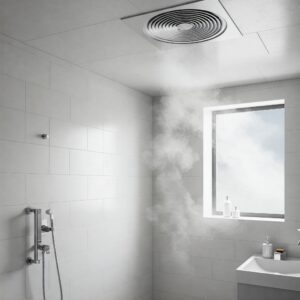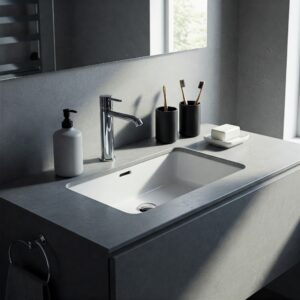Clean, safe, and good-tasting water is fundamental to a healthy life and a functional kitchen. While tap water in many areas undergoes municipal treatment, concerns often remain about its taste, odor, or the presence of specific contaminants. In regions like Indonesia, common issues can range from sediment and chlorine taste from municipal sources to worries about microbial safety in untreated water sources. Kitchen water filtration systems offer a practical and effective solution, providing convenient access to improved water for drinking, cooking, and preparing beverages right at the point of use.
This guide explores why you might consider a filtration system, the different types available, common filtration technologies, and key factors to help you choose the right one for your kitchen.
Why Consider a Kitchen Water Filtration System? (Benefits)
Investing in a kitchen water filter offers numerous advantages:
- Improved Taste and Odor: Significantly reduces chlorine (often used in municipal water treatment), sulfur, and other substances that can give tap water an unpleasant taste or smell. This is particularly beneficial in Indonesia where varying water sources can impact flavor.
- Removal of Contaminants: Depending on the type, filters can remove a wide range of impurities:
- Sediment & Particulates: Dirt, rust, sand, and other suspended particles, which can be common in areas with older piping or variable water sources.
- Heavy Metals: Such as lead (from old pipes), mercury, and cadmium.
- Chemicals: Pesticides, herbicides, industrial solvents, and volatile organic compounds (VOCs).
- Microbiological Contaminants: Certain advanced systems can remove bacteria, viruses, and cysts, crucial if you’re concerned about the microbiological safety of your tap water.
- Healthier Drinking Water: By reducing harmful contaminants, you ensure your family is drinking safer water.
- Cost Savings: Can be significantly more cost-effective in the long run compared to continuously buying bottled water, a common practice in many Indonesian households.
- Environmental Benefits: Drastically reduces the consumption of single-use plastic water bottles, contributing to less plastic waste.
- Convenience: Provides filtered water on demand directly from your tap or a dedicated faucet.
- Better Tasting Food and Beverages: Using filtered water for cooking, making coffee, tea, or ice cubes can noticeably improve their flavor.
Common Contaminants in Tap Water
Water quality varies greatly by location and source (municipal, well, etc.). Some common concerns globally, and potentially in parts of Indonesia, include:
- Chlorine: Used for disinfection in municipal water but affects taste and odor.
- Sediment, Silt, and Rust: Particles from pipes or the water source.
- Heavy Metals: Lead, mercury, arsenic, cadmium from plumbing or industrial pollution.
- Pesticides & Herbicides: Runoff from agricultural areas.
- Volatile Organic Compounds (VOCs): From industrial or commercial discharge.
- Bacteria, Viruses & Cysts: A concern primarily with untreated water sources or if there are issues with municipal treatment integrity.
- Hardness Minerals (Calcium, Magnesium): While not a health risk, can cause scale buildup. Most standard filters don’t significantly soften water, but some specialized systems do.
To understand your specific water quality, consider local water reports or private water testing if you have particular concerns.
Types of Kitchen Water Filtration Systems
Several types of filters are designed for kitchen use:
- Water Filter Pitchers (e.g., Brita, PUR):
- How they work: Water is poured into a top reservoir and filters by gravity through a cartridge (usually activated carbon) into the pitcher below.
- Pros: Affordable, portable, no installation required, easy to use.
- Cons: Small capacity, relatively slow filtering process, requires frequent filter replacements, removes a limited range of contaminants (mainly chlorine, some sediment, improves taste/odor).
- Faucet-Mounted Filters:
- How they work: Attach directly to your existing kitchen faucet. A diverter switch allows you to choose between filtered and unfiltered water. Typically use activated carbon.
- Pros: Convenient for on-demand filtered water, relatively inexpensive, easy to install.
- Cons: Can slow down water flow, may not fit all faucet types, filters need frequent replacement.
- Countertop Filters:
- How they work: Sit on the countertop and connect to the existing faucet via a diverter hose. Can offer more advanced filtration than pitchers or faucet mounts due to larger filter cartridges (e.g., multi-stage carbon, ceramic).
- Pros: Better filtration and longer filter life than pitchers/faucet filters, easy to set up.
- Cons: Take up counter space, still visible.
- Under-Sink Filters (Point-of-Use):
- How they work: Installed beneath the kitchen sink and connect directly to the cold water line. Usually dispense filtered water through a dedicated, smaller secondary faucet installed on the sink deck. Often employ multi-stage filtration.
- Pros: Highly convenient, out of sight, provide excellent filtration for a wide range of contaminants, filters last longer (e.g., 6-12 months).
- Cons: Requires plumbing installation (can be DIY or professional), higher initial cost.
- Reverse Osmosis (RO) Systems (Typically Under-Sink):
- How they work: Water is forced through a semi-permeable membrane that removes a very broad spectrum of contaminants by physically blocking them. RO systems typically include pre-filters (sediment, carbon) and often a post-filter (carbon).
- Pros: Removes the widest range of contaminants, including dissolved solids, heavy metals (lead, arsenic), fluoride, nitrates, chlorine, sediment, bacteria, and viruses (if NSF/ANSI Standard 58 certified for cyst/bacteria/virus reduction). Produces very pure water.
- Cons: More expensive, require installation and a dedicated faucet, produce wastewater (brine) during the filtration process (ratio varies), slower water production rate (often requires a storage tank), can strip beneficial minerals from water (some systems include a remineralization stage to add them back).
- Whole-House Water Filters (Point-of-Entry – Briefly Mentioned):
- These systems filter all water entering your home. While excellent for overall water quality (showers, laundry), they are a different category than targeted kitchen drinking water filters. Often used in conjunction with a point-of-use drinking water filter for final polishing.
Common Filtration Technologies Explained
- Activated Carbon: Adsorbs contaminants. Very effective for chlorine, VOCs, pesticides, and improving taste and odor. Can be made from coconut shells, wood, or coal.
- Sediment Filters: Physically block larger particles like sand, silt, rust, and dirt. Often used as a pre-filter.
- Reverse Osmosis (RO) Membrane: A very fine membrane that blocks a vast array of dissolved solids, minerals, metals, and microorganisms.
- UV (Ultraviolet) Purification: Uses UV light to kill or inactivate bacteria, viruses, and other microorganisms. Chemical-free disinfection. Often used as a final stage after other filtration.
- Ceramic Filters: Have a microporous structure that physically blocks sediment, bacteria, and cysts. Often cleanable.
Choosing the Right Kitchen Water Filtration System
Consider these factors:
- Identify Your Water Quality Concerns: What do you specifically want to remove? Is it just taste and odor (chlorine, sediment), or are you concerned about heavy metals, bacteria, or specific chemicals? If unsure, look for local water quality reports or consider a home water test.
- Budget: Evaluate both the upfront cost of the system and the ongoing cost of filter replacements.
- Installation & Space: Do you have space under your sink? Are you comfortable with minor plumbing, or will you need a professional?
- Flow Rate & Capacity: How much filtered water does your household need daily? Pitchers are slow; under-sink systems offer higher flow.
- Filter Lifespan & Replacement Costs: Factor in the frequency and cost of changing filters.
- Certifications: Look for certifications from independent organizations like NSF International or WQA (Water Quality Association). These certifications verify that a filter removes the contaminants it claims to (e.g., NSF/ANSI Standard 42 for aesthetic effects like chlorine, Standard 53 for health effects like lead/cysts, Standard 58 for RO systems, Standard 55 for UV systems). Check for locally recognized certifications in Indonesia if available.
- Maintenance: Understand the maintenance requirements for the system.
Conclusion
A kitchen water filtration system is a valuable investment for enhancing the taste, safety, and quality of your drinking and cooking water. From simple pitchers to advanced reverse osmosis units, a wide range of options exists to suit different needs and budgets. By understanding your local water quality, identifying the contaminants you wish to remove, and considering factors like installation, maintenance, and filter life, you can choose a system that provides your family with cleaner, healthier, and better-tasting water right from your kitchen tap. This can be particularly beneficial in areas like Indonesia, offering peace of mind and a more sustainable alternative to bottled water.







Leave a Comment